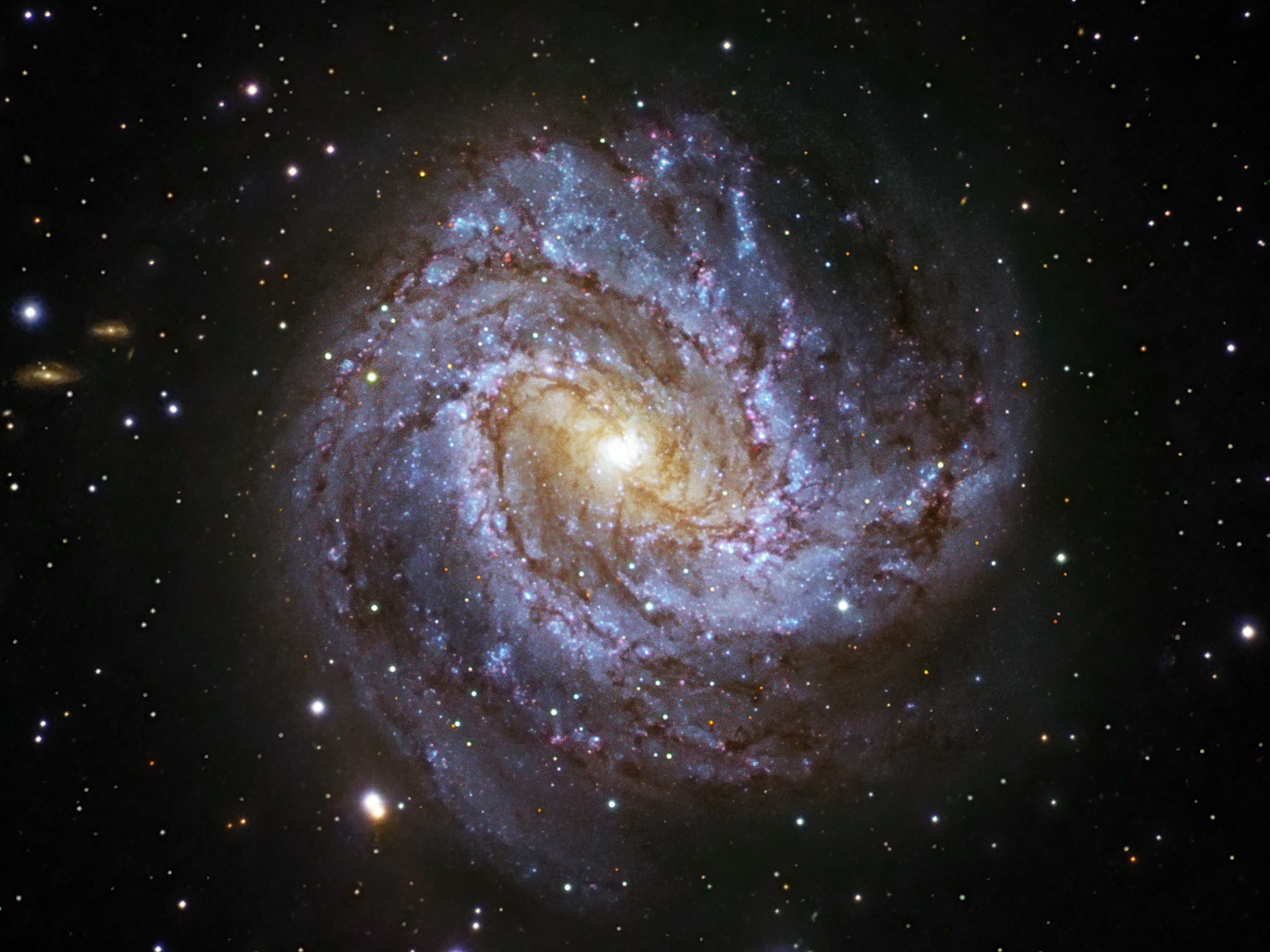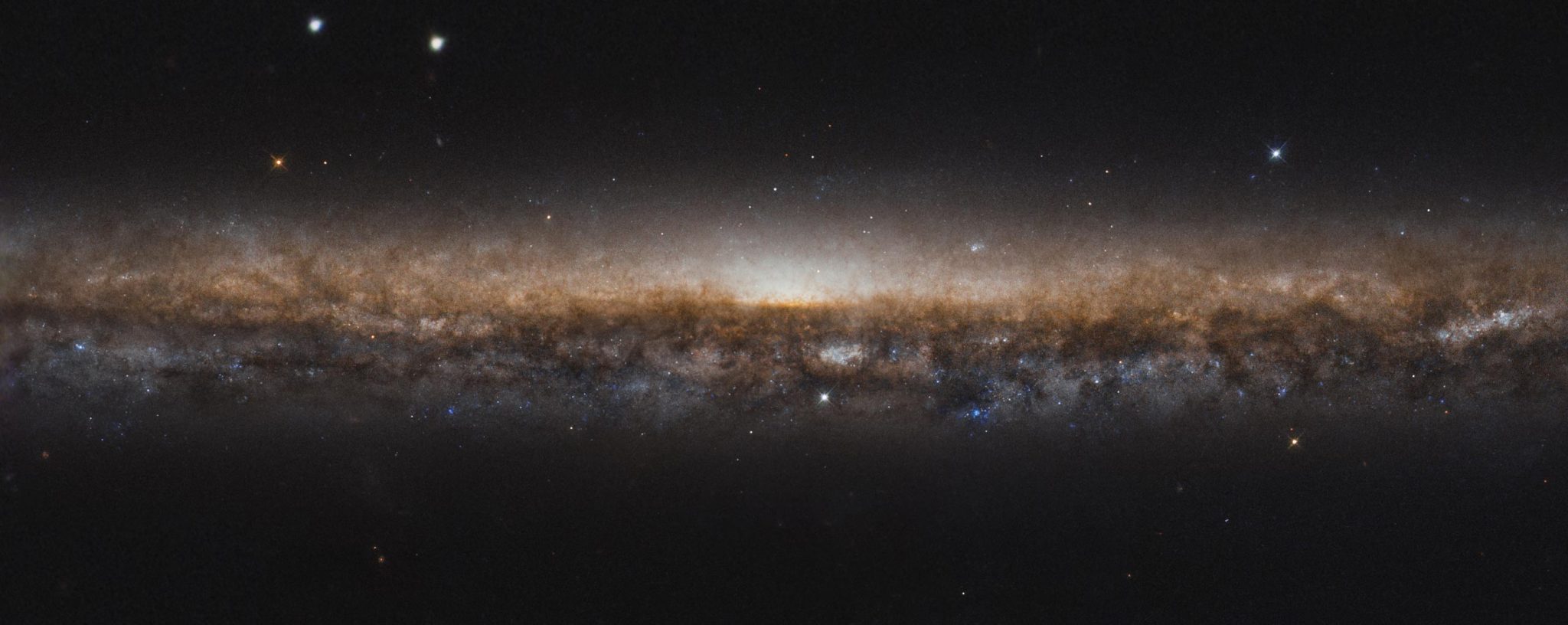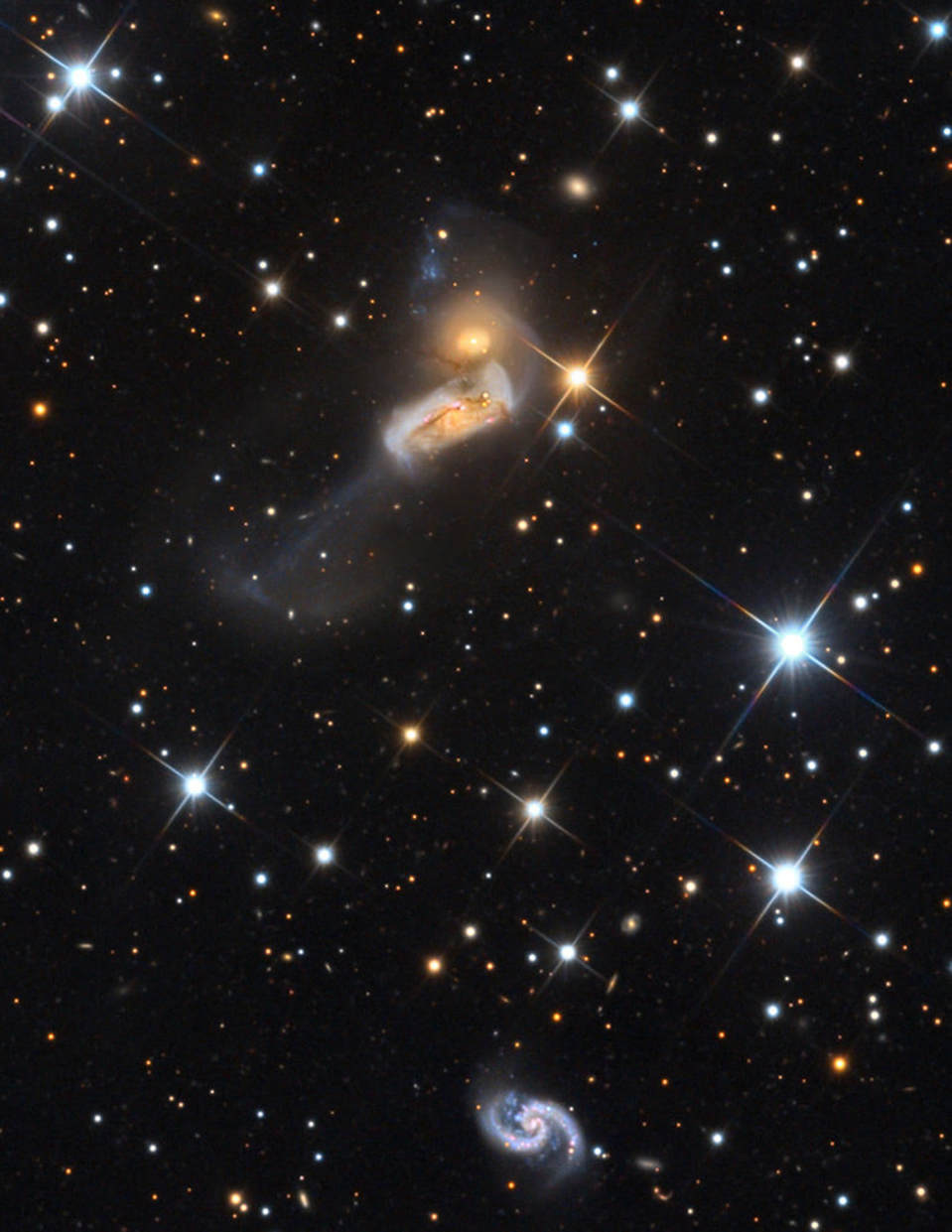Blog
David “Honeyboy” Edwards (June 28, 1915 – August 29, 2011) was a Delta blues guitarist and singer from Mississippi.
Edwards was born in Shaw, Mississippi. At the age of 14, he left home to travel with the bluesman Big Joe Williams, beginning life as an itinerant musician, which he maintained through the 1930s and 1940s. He performed with the famed blues musician Robert Johnson, with whom he developed a close friendship. Edwards was present on the night Johnson drank the poisoned whiskey that killed him, and his story has become the definitive version of Johnson’s demise. Edwards also knew and played with other leading bluesmen in the Mississippi Delta, including Charley Patton, Tommy Johnson, and Johnny Shines.
more...Located about 15 million light-years away towards the Hydra (the sea serpent) constellation, Messier 83 is a nearby face-on barred spiral with a classic grand design form. It is the main member of a small galactic group including NGC 5253 and about 9 dwarf galaxies. Messier 83 stretches over 40,000 light-years, making it roughly 2.5 times smaller than our own Milky Way. However, in some respects, Messier 83 is quite similar to our own galaxy. Both the Milky Way and Messier 83 possess a bar across their galactic nucleus, the dense spherical conglomeration of stars seen at the centre of the galaxies.
Messier 83 has been a prolific producer of supernovae, with six observed in the past century. This is indicative of an exceptionally high rate of star formation coinciding with its classification as a starburst galaxy. Despite its symmetric appearance, the central 1,000 light-years of the galaxy shows an unusually high level of complexity, containing both a double nucleus and a double circumnuclear starburst ring. The nature of the double nucleus is uncertain but the off centre nucleus could be a remnant core of a small galaxy that merged with Messier 83 in the past. The star clusters in the nuclear starburst rings are mostly young stars between 5 and 10 million years old. This image is based on data acquired with the 1.5-metre Danish telescope at ESO’s La Silla Observatory in Chile, through three filters (B, V, R).

Khadja Nin (born 27 June 1959) is a Burundian singer and musician.
Nin was born in Burundi, the youngest of a family of eight. Her father was a diplomat. She studied music at an early age like most of her brothers and sisters. With her exceptional singing voice, at the age of seven she became one of the lead vocalists in the Bujumbura choir and performed in the local cathedral. She left Burundi for Zaire in 1975 and married in 1978. In 1980 she emigrated to Belgium with her two-year-old son. In 1985 she obtained a contract with BMG. Her second album, a 1994 release entitled Ya Pili, was critically acclaimed.
Her breakthrough came in 1996 with her widely popular album Sambolera, which was sung in Swahili, Kirundi, and French. In 1997 she performed the song “Sailing” in a duet with Montserrat Caballé on the album Friends For Life. She successfully used a blend between African rhythms and modern pop to create her own unique brand of music. One of her most popular songs is Sina Mali, Sina Deni, a translated cover version of Stevie Wonder‘s song Free.
The first album was released in 1992, sung in Swahili. But it is best known in France in 1995 with the tube Sambolera mali sound, a title of the second album, Ya Pili (The second). The third album is a compilation of old and new titles. Jeanne Moreau makes the clip illustrating her song Mama, where she talks about her mother, on her fourth album Ya … . The texts of this album are in Swahili or Kirundi (for the chorus of the title Mama). The album also includes a cover of a piece by Gabonese musician Pierre Akendengué, Africa Obota, and a title of Stevie Wonder, Free that she renamed Sina mali, sina deni (I am neither rich nor indebted). Another piece pays tribute to Nelson Mandela, and a song calls for easing the embargo imposed on Burundi.
In January 2000, she sang at AccorHotels Arena (at the time Palais Omnisports de Paris-Bercy) with Sting and Cheb Mami. She remarries in 2006 with the Belgian car driver Jacky Ickx, and they settle in Monaco. In this marriage, she has had a son who now lives in Belgium.
In 2018, she was a jury member at the Cannes Film Festival, under the presidency of Cate Blanchett, alongside actresses Léa Seydoux and Kristen Stewart, director Ava DuVernay, actor Chang Chen and directors Robert Guédiguian, Denis Villeneuve and Andrey Zvyagintsev.
more...George Braith (born George Timothy Braithwaite on June 26, 1939) is a soul-jazz saxophonist from New York. Braith is known for playing multiple horns at once, a technique pioneered by Roland Kirk. Braith is credited with the invention of the Braithophone, two different horns (straight alto and soprano) mended together by extensions, valves and connections.
Braith is featured in a mosaic in the 72nd street station of the Second Avenue Subway in the New York City Subway system.
Of Braith’s album Musart Thom Jurek at AllMusic wrote, “Musart is his masterpiece; it is one of the most diverse yet refined albums to come out of the ’60s, and has few peers even today.”
more...Johnny “Big Moose” Walker (June 27, 1927 – November 27, 1999) was an American Chicago blues and electric blues pianist and organist. He worked with many blues musicians, including Ike Turner, Sonny Boy Williamson II, Lowell Fulson, Choker Campbell, Elmore James, Earl Hooker, Muddy Waters, Otis Spann, Sunnyland Slim, Jimmy Dawkins and Son Seals.[2]
Walker was primarily a piano player but was also proficient on the electronic organ and the bass guitar (he played the bass guitar when backing Muddy Waters). He recorded solo albums and accompanied other musicians in concert and on recordings.
John Mayon Walker was born in the unincorporated community of Stoneville, Mississippi, partly of Native American ancestry. He acquired his best-known stage name in his childhood in Greenville, Mississippi, derived from his long, flowing hair. He learned to play several instruments, including the church organ, guitar, vibraphone and tuba.
He began his musical career as a pianist, in 1947, touring with various blues bands and backing such notable artists as Ike Turner, Sonny Boy Williamson II, Elmore James, Lowell Fulson and Choker Campbell. Walker served in the United States Army from 1952 to 1955, serving during the Korean War. In 1955, billed as Moose John, Ultra Records released the single, “Talkin’ ‘Bout Me”. His own recordings, released under various names, were unsuccessful, but Walker started working more consistently in the mid-1950s, notably backing Earl Hooker and Elmore James.Walker moved to Chicago in the late 1950s and over the next decade accompanied Sunnyland Slim, Otis Rush, Muddy Waters (for whom Walker played bass guitar), Ricky Allen, Little Johnny Jones, and Howlin’ Wolf.[4] In 1960, he accompanied Junior Wells on his best-known recording, “Messin’ with the Kid“. The following year Walker played on James’s recordings of “Look on Yonder Wall” and “Shake Your Moneymaker“. In 1962, Walker played on Waters’s recording of “You Shook Me“. During the 1960s, a couple of obscure Chicago-based record labels, Age and The Blues, released Walker’s solo singles.
more...St. Elmo Sylvester Hope (June 27, 1923 – May 19, 1967) was an American jazz pianist, composer, and arranger, chiefly in the bebop and hard bopgenres. He grew up playing and listening to jazz and classical music with Bud Powell, and both were close friends of another influential pianist, Thelonious Monk.
Hope survived being shot by police as a youth to become a New York-based musician who recorded with several emerging stars in the early to mid-1950s, including trumpeter Clifford Brown, and saxophonists John Coltrane, Lou Donaldson, Jackie McLean, and Sonny Rollins. A long-term heroin user, Hope had his license to perform in New York’s clubs withdrawn after a drug conviction, so he moved to Los Angeles in 1957. He was not happy during his four years on the West Coast, but had some successful collaborations there, including with saxophonist Harold Land.
More recordings as leader ensued following Hope’s return to New York, but they did little to gain him more public or critical attention. Further drug and health problems reduced the frequency of his public performances, which ended a year before his death, at the age of 43. He remains little known, despite, or because of, the individuality of his playing and composing, which were complex and stressed subtlety and variation rather than the virtuosity predominant in bebop.
Elmo Hope was born on June 27, 1923, in New York City. His parents, Simon and Gertrude Hope, were immigrants from the Caribbean, and had several children. Elmo began playing the piano aged seven. He had classical music lessons as a child, and won solo piano recital contests from 1938. Fellow pianist Bud Powell was a childhood friend; together, they played and listened to jazz and classical music. Hope attended Benjamin Franklin High School, which was known for its music program. He developed an excellent understanding of harmony, and composed jazz and classical pieces at school.
more...The galaxy known as NGC 5907 stretches wide across this image. Appearing as an elongated line of stars and dark dust, the galaxy is categorized as a spiral galaxy just like our own Milky Way. In this new image from the NASA/ESA Hubble Space Telescope, we don’t see the beautiful spiral arms because we are viewing it edge-on, like looking at the rim of a plate. It is for this reason that NGC 5907 is also known as the Knife Edge Galaxy.
The Knife Edge Galaxy is about 50 million light-years from Earth, lying in the northern constellation of Draco. Although not visible in this image, ghostly streams of stars on large arching loops extend into space, circling around the galaxy; they are believed to be remnants of a small dwarf galaxy, torn apart by the Knife Edge Galaxy and merged with it over four billion years ago.

Gilberto Passos Gil Moreira (born 26 June 1942), known professionally as Gilberto Gil (Brazilian Portuguese: [ʒiwˈbɛʁtu ˈʒiw]), is a Brazilian singer, guitarist, and songwriter, known for both his musical innovation and political activism. From 2003 to 2008, he served as Brazil’s Minister of Culture in the administration of President Luiz Inácio Lula da Silva. Gil’s musical style incorporates an eclectic range of influences, including rock, Brazilian genres including samba, African music, and reggae.
Gil started to play music as a child and was a teenager when he joined his first band. He began his career as a bossa nova musician and grew to write songs that reflected a focus on political awareness and social activism. He was a key figure in the Música popular brasileira and tropicália movements of the 1960s, alongside artists such as longtime collaborator Caetano Veloso. The Brazilian military regime that took power in 1964 saw both Gil and Veloso as a threat, and the two were held for nine months in 1969 before they were told to leave the country. Gil moved to London, but returned to Bahia in 1972 and continued his musical career, as well as working as a politician and environmental advocate.
more...Reginald “Reggie” Workman (born June 26, 1937 in Philadelphia, Pennsylvania) is an American avant-garde jazz and hard bop double bassist, recognized for his work with both John Coltrane and Art Blakey.
Early in his career, Workman worked in jazz groups led by Gigi Gryce, Donald Byrd, Duke Jordan and Booker Little. In 1961, Workman joined the John Coltrane Quartet, replacing Steve Davis. He was present for the saxophonist’s Live at the Village Vanguard sessions, and also recorded with a second bassist (Art Davis) on the 1961 album, Olé Coltrane. Workman left Coltrane’s group at the end of the year, following a European tour.
In 1962, Workman joined Art Blakey‘s Jazz Messengers (replacing long-time Blakey bassist Jymie Merritt), and worked alongside Freddie Hubbard, Wayne Shorter, and Cedar Walton for most of this period. Workman left Blakey’s group in 1964.
Workman also played with James Moody, Yusef Lateef, Pharoah Sanders, Herbie Mann and Thelonious Monk. He has recorded with Archie Shepp, Lee Morgan and David Murray.[1] Workman, with pianist Tommy Flanagan and drummer Joe Chambers, formed The Super Jazz Trio in 1978.
He is currently a professor at The New School for Jazz and Contemporary Music in New York City, and is a member of the group, Trio 3, with Oliver Lake and Andrew Cyrille.
Workman has been a resident of Montclair, New Jersey
more...Big Bill Broonzy (born Lee Conley Bradley, June 26, 1903 – August 14, 1958) was an American blues singer, songwriter and guitarist. His career began in the 1920s, when he played country blues to mostly African-American audiences. Through the 1930s and 1940s he successfully navigated a transition in style to a more urban blues sound popular with working-class African-American audiences. In the 1950s a return to his traditional folk-blues roots made him one of the leading figures of the emerging American folk music revival and an international star. His long and varied career marks him as one of the key figures in the development of blues music in the 20th century.
Broonzy copyrighted more than 300 songs during his lifetime, including both adaptations of traditional folk songs and original blues songs. As a blues composer, he was unique in writing songs that reflected his rural-to-urban experiences.
Born Lee Conley Bradley, he was one of the seventeen children of Frank Broonzy (Bradley) and Mittie Belcher. The date and place of his birth are disputed. Broonzy claimed to have been born in Scott, Mississippi, but a body of emerging research compiled by the blues historian Robert Reisman suggests that he was born in Jefferson County, Arkansas. Broonzy claimed he was born in 1893, and many sources report that year, but family records discovered after his death suggested that the year was 1903.
more...Alegrías (Spanish pronunciation: [aleˈɣɾi.as]) is a flamenco palo or musical form, which has a rhythm consisting of 12 beats. It is similar to Soleares. Its beat emphasis is as follows: 1 2 [3] 4 5 [6] 7 [8]9 [10] 11 [12]. Alegrías originated in Cádiz. Alegrías belongs to the group of palos called Cantiñas and it is usually played in a lively rhythm (120-170 beats per minute). The livelier speeds are chosen for dancing, while quieter rhythms are preferred for the song alone.
One of the structurally strictest forms of flamenco, a traditional dance in alegrías must contain each of the following sections: a salida (entrance), paseo (walkaround), silencio (similar to an adagio in ballet), castellana (upbeat section) zapateado (Literally “a tap of the foot”) and bulerías. This structure though, is not followed when alegrías are sung as a standalone song (with no dancing). In that case, the stanzas are combined freely, sometimes together with other types of cantiñas.
Recommended listenings for this palo include most singers from Cádiz, like Chano Lobato, La Perla de Cádiz, Aurelio Sellé, but also general singers like Manolo Caracol or La Niña de los Peines.
Also, you can listen “Mar Amargo” from Camarón and “La Tarde es Caramelo” from Vicente Amigo.
It is one of the cante chico forms of flamenco. The word Alegrías literally means “joys.”
more...https://www.youtube.com/watch?v=uN7vm-k-AaA
more...NGC 317 is a pair of interacting galaxies, consisting of a lenticular galaxy (PGC 3442) and a spiral galaxy (PGC 3345), in the constellation Andromeda. It was discovered on October 1, 1885 by Lewis Swift.

More Posts
- Chet Baker
- World Music The Bothy Band
- Daily Roots Carlene Davis & Naomi Cowan
- Cosmos NGC 1360
- Lil Green
- John Patitucci
- Ronnie Ball
- World Music Parisa Pouladian
- Daily Roots Mickey Simpson
- Happy Winter Solstice 2024
- Cosmos Sh2-106
- John Hicks
- Harmonica Slim
- Paco de Lucía
- Frank Zappa
- Hank Crawford
- World Music Fabio Bergamini
- Daily Roots Junior Delgado
- Historic Reality
- Mr Natural Santa